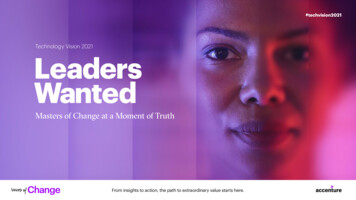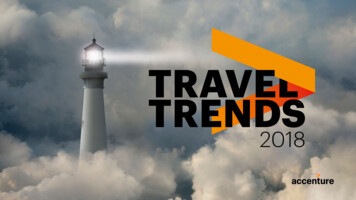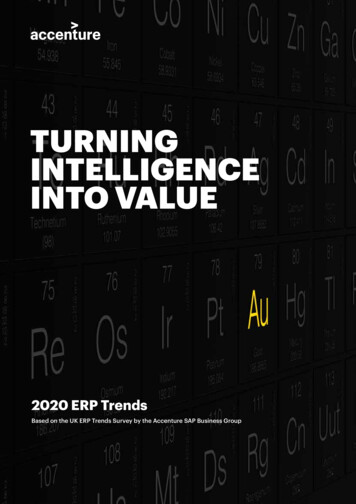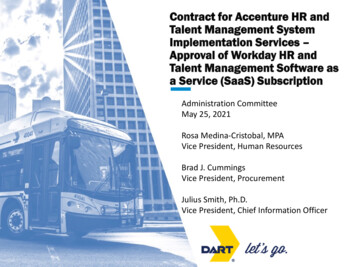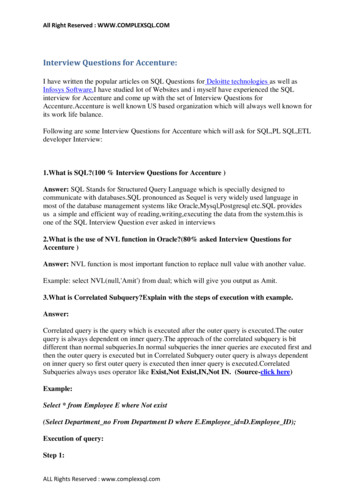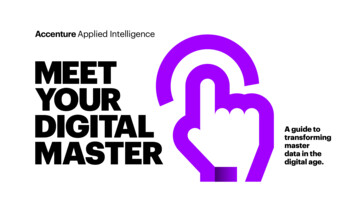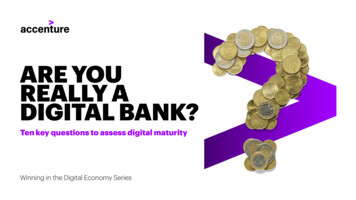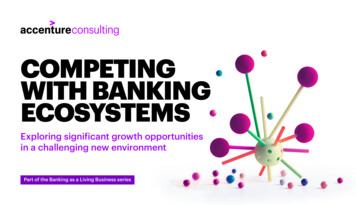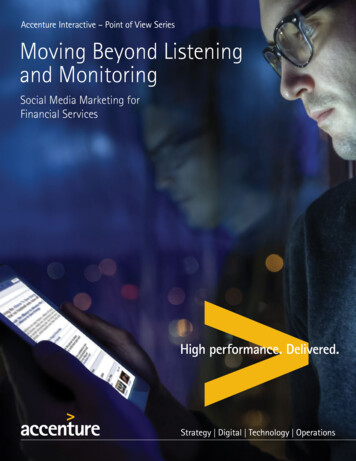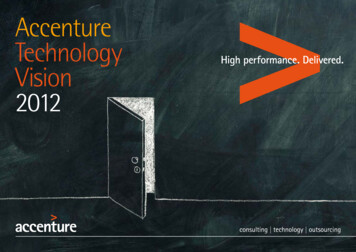
Transcription
AccentureTechnologyVision2012
ContentsForewordIntroduction23Technology TrendsContext-based servicesConverging data architecturesIndustrialized data servicesSocial-driven ITPaaS-enabled agilityOrchestrated analytical security41016232936ImplicationsThe CEO’s agendaIT’s agenda4345Research methodologyEnd notesContacts484950
ForewordAccenture Technology Vision 2012We bring the Accenture Technology Vision 2012 to you at atime of unprecedented change in the global economy and thetechnology landscape. Our clients tell us that technology ismore important than ever to their business success. Some ofthem sense that the world is on the verge of a new technologyrevolution. We agree.This next revolution will differ from previousdisruptions. This time, technology is presentin every aspect of our lives. The lines betweenconsumer and corporate technology continue toblur. On-premise and off-premise technology aremelding to drive much quicker processing—andfaster and better business results. The flexibilityof new technologies and architectures is forcingus all to rethink how we harness IT to makeit easier for our organizations to innovate.The Accenture Technology Vision 2012 isdesigned to help you identify these changes—tomake sense of the disruptions. But this year’sreport challenges companies to go a stepbeyond understanding—to start taking action.We urge you to plan thoughtful, appropriateresponses and seize new opportunities.2It is time to focus on technology as a driver forgrowth and take the bold decisions to movebeyond IT’s legacy constraints—constraintsthat make it too difficult to change, toocostly to pursue new opportunities.The coming transformation journey—changingIT from roadblock to driver—won’t be easy. Itwill call for a comprehensive strategy that leadsto new architectures, new services, and newplatforms. And it will demand prompt, disciplinedexecution to bring those new approaches to life.The technology that you use will be radicallydifferent three years from now. Stand still andyou risk being left behind. Act now and you willbe poised for continued growth in the future.Pierre NantermeChief Executive OfficerAccentureKevin CampbellGroup Chief Executive - TechnologyAccenture
IntroductionAccenture Technology Vision 2012Responding to what’s aheadSome drivers have an advantage over othermotorists: they can see around cornersat night. With adaptive headlights in theircars—lamps that swivel a few degrees whenthey detect that the car is turning—thesedrivers can spot the deer in the road afew milliseconds before the rest of us.To take prompt action, every CIO requires theinformation equivalent of adaptive headlights—the ability to identify relevant trends beforeothers do. Indeed, they and their businesscolleagues need the clearest possible guidanceabout changes in information technologies.With the right guidance, they can effectivelylead their organizations as they adapt tothe rapidly changing world we live in.CIOs are feeling the pressure of a bevyof technology forces—forces like thesuperabundance of computing powerand capacity and the soaring technologyexpectations of consumers, employees, andeven CEOs. Discussions on the impact of cloudcomputing and mobility have become routine.IT organizations are just beginning to wrap theirminds around Big Data. They’re pushing to weaveanalytics deeper into the organization. Andsome are asking themselves what to make of theperennial discussion of the Internet of Things.Yet even as CIOs begin to react, the list ofchange-making technologies continues togrow. Recognizing that forces such as the cloudare just the starting point, Accenture’s annualTechnology Vision provides our perspectiveon the future of technology beyond theconversations already on the table. This year’sreport—Technology Vision 2012—outlines thenew technology trends that forward-thinkingCIOs will use to position their organizationsto drive growth, rather than focusing oncost-cutting and efficiency improvements.Increasingly, business leaders find that theirorganizations’ success relies on keeping pacewith rapidly shifting technology. Companiesmust be prepared to recognize and takeadvantage of new opportunities enabled bynew trends, like context-based services orsocial technologies. But the new moves willcome at a price. To change with the worldquickly and cost-effectively, there must be anew IT base—new architectures, new services,new platforms. And with a new IT base comenew risks and new precautions, so informationsecurity has to become a top agenda item.Doing so means starting this journey togetherwith the business. It demands detaileddiscussions with the rest of the C-suite. It willcall for CIOs to internalize these trends sothey can start framing these discussions—nottalking about the technologies themselvesbut about the impact they will have on thebusiness, and the new initiatives they can drive.Some of you are already leading thoseconversations with your business colleagues—and with your IT staff. For those who aren’t,are you ready?IT leaders must take action now. They must bethe ones who lead their enterprises throughthis turbulent new world. Inside 100 daysof reading this report, they should havebegun to map out their strategies to leveragethese trends over the long haul. Within 12months, they should be starting to executethese plans to put their enterprises on thepath to new organizations, new processes,new systems—even a new frame of mind.3
Context-based servicesContext—where you are and what you’re doing—will drive the next wave of digital services4
Trend 1 - Context-based servicesAccenture Technology Vision 2012
Trend 1 - Context-based servicesAccenture Technology Vision 2012Forget about the much-discussed Internet of Things. The reallyinteresting news is that data from a host of new sources,combined with technologies that rapidly aggregate and analyzethe data, will deliver fresh insights that can give users much moreimmersive and valuable experiences online—and in the real world.Services that alert you to the nearest Starbucksor gas station just aren’t enough for users thesedays. Those services don’t “know” you; theydon’t know what you’re trying to do right now.What can still attract users? Services thatcombine real-time signals from the physicalworld with location data, online activities, socialmedia, and many other types of contextualinputs. It might be support for a pharmaceuticalsales rep tailored to the context of the doctorsshe will be meeting and the drugs she’s selling. Itcould be data made available to a technician atan oil refinery, customized to the equipment he’sservicing and what its downtime history lookslike. Or it might be a shopping app that gives acustomer fast access to more information abouta new jacket whose quick response (QR) codeshe’s scanned in the store; tells her how far sheis from stores that carry other sizes of the jacket;alerts her to her available credit balance; andgets instant opinions, via Facebook, from herfriends about whether they like the jacket or not.The new high ground for data services is not inlocation-based apps. It is in a kaleidoscope ofcontext that adds up to rich user experiences—far more alluring than simple indications ofhow many friends are inside the same one-6mile radius or what route to walk from thissubway stop to that unfamiliar office building.meet the renter at the scene, greatly improvingthe chances of creating a loyal customer for life).Today, we have ready access to enough historicaland real-time data and we know enough aboutwhat is happening in enough places to be able tooffer services that are enabling and entertaining.More data, by itself, isn’t enough—technologynow enables rapid aggregation of data frommultiple sources and delivers new insightsthat can give users much more immersive andvaluable experiences. The key—beyond theproliferation of data and the ability to analyzeit every which way—is to ensure that contextenables the services that make sense rightat the point where an action takes place. Ineffect, context allows organizations to shifttheir focus from insight (for example, businesstravelers place a premium on the ease andspeed of interaction when choosing rental carcompanies) to actionable insight (streamliningthe car rental process allows frequent rentersto avoid lines, thus increasing customer loyalty)to insight at the point of action (for instance,the rental company automatically detects whenan accident with one of its cars has happened,proactively initiates emergency services ifneeded, and issues a replacement rental car toCIOs and other IT leaders who get it—whograsp the importance of context-basedconnections—will be able to establishthemselves, and their organizations, as strategicplayers. They will immediately be able to offernew levels of insight that will differentiatetheir organizations from competitors.What context-based services aren’tIt’s important to deflect any misconceptionsabout context-based data services. To beginwith, they are not about “really cool” mobilephone handsets—regardless of how much theirnew apps may impress. Although devices such asmobiles are indeed essential vehicles for some ofthose services, that is all they are. Mobility is justone of many factors that help to convey context.Nor are context-based services all about thecloud. It’s true that connected devices—mobileand otherwise—will exchange data with cloudbased service providers, but the cloud is nothingmore than a logical data-aggregation point.Similarly, “context-based” is not synonymouswith “location-based.” The importance of being
Trend 1 - Context-based servicesable to integrate data from the physical worldbeyond location—inputs from QR codes are onlyone example—must not be underestimated. Andcontext is not just another example of socialmedia, although social certainly adds contextsuch as shared interests or opinions. It’s inthe aggregation of all of these things that wetruly see the power of context-based services.They create an experience that adds levels ofutility and richness—and yes, complexity—thatwere not possible even just a few years ago.Context-based services thattranscend mobile appsContext-based services have existed inrudimentary forms for some time; to an extent,they are evident in the Internet of Things—forinstance, in the real-time readings on paceand time that marathon runners receive froma transmitter tag laced to a shoe. They arealso apparent in the recommendation enginesused by sites such as Amazon, Netflix, andLinkedIn. Recommendation software notonly keeps track of your personalized historyand uses it to infer interests; today, it canproduce suggestions based on what othersin your social circle or professional groupare doing. For instance, if other users in yournetwork are reading a popular business book,a site may propose that you purchase it,too—and provide a one-click link to do so.And of course many phones—they do noteven have to fit the definition of Webready smartphones that access vast storesof apps—have location-sensing capabilitiesthat provide their users with usefulproximity data, route planning, and more.Accenture Technology Vision 2012The next few years are likely to see an expansionin the volumes and types of sensors availableto add context. The industrial world alreadybenefits from radio frequency ID (RFID) systemsin which RFID-tagged items supply contextualdata about their locations, time, temperature,and much more. Now we anticipate a rushof specialty devices that will excel in nicheareas—health monitors that test for bloodsugar levels, for instance, or wristbands thattransmit signals about a patient’s activitylevels to mobile-linked health care systemsthat add context about family health historyto enable patients to improve their own healthcare. Apple’s latest iPhone, for instance,contains Bluetooth Smart technology—anew standard that supports connections tosensors that consume very little power.The power of contextOne other source of context is in what isshared—which is where blogs, chat rooms,message boards, social media, productreviews, and the countless other wells ofonline data come in. We can detect or infercertain information about others based on ourinteractions with them or, even more simply,we can give them the opportunity to shareit themselves. It turns out that users readilyshare meaningful personal context; they justneed to have a compelling reason to do so.So when a retailer provides QR codes in itsstores, it enables the shopper to access newand valuable sources of information about aproduct or service. Because this is something theconsumer wasn’t able to do before—or wasn’table to do with such ease and reliability—he iswilling to trade some personal data in exchange.That data in turn becomes valuable not only forthe retailer and the original producer but forothers in the shopper’s social network as well.Given richer context—access to the shopper’sinterests, shopping history, or age, perhaps—providers will offer services that better alignwith his needs and wants. Indeed, we expectthat products, services, retailers, and enterpriseswill be differentiated based on their abilityto meet users’ requirements in this way.The power of context will enrich not only onlineinteractions but real-world ones as well. Today,online shopping experiences have surpassedwhat is usually available in the physical world;it is possible to view different colors, styles,sizes, and availability of merchandise; to putshopping carts on hold; to pay in many differentways; to redeem coupons easily; and more. Thenext few years will see a push toward mergingthe physical and virtual shopping experiences.Blippar, for example, offers augmented realitycapabilities that allow retailers to experimentwith doing just that today. And Shopkickenriches the in-store shopping experience withpersonalized offers, highlights products thatothers have liked, and rewards customers forwalking into selected stores. The reward forwalking in is just the bait; the context piececomes from location (knowing you’re in thestore), understanding interests and intent(scanning an item you’re thinking about), andsocial connections (knowing what others liked).What it means forthe business New products and services based oncontext from inside and outside of theenterprise New contextual data services thatenable companies to more easily addcapabilities to their existing products New capabilities to experiment withnew services and iterate quickly basedon pilotsThe emergence of more context-basedservices will have a compounding— thosenew services themselves provide additionalsources of context. The expanding richnessof context will be a fast-moving capabilitythat enterprises will need to watch.7
Trend 1 - Context-based servicesThis time next yearOver the next 12 months, the ITorganization should: Create strong links with businessfunctions that directly influence theconsumer experience. Compile a firm list of context-basedservices that is regularly updatedas circumstances change—and thatforms the basis of discussion withthe business side in order to drivethe platform for context across theenterprise. Form a pilot team that blends userexperience specialists with datascientists to experiment with newcontextual data services. Establish an environment that enablesexperimentation—rapid development,planning, and deployment. Begin developing a data platform tohandle contextual data and analytics,including appropriate privacy controlson potentially sensitive personalinformation. Develop a data roadmap to depict howto acquire the critical data necessaryfor the next generation of contextbased services.8Accenture Technology Vision 2012“CIOs and other IT leaders who get it—whograsp the importance of context-basedconnections—will be able to establishthemselves, and their organizations, asstrategic players. They will immediatelybe able to offer new levels of insight thatwill differentiate their organizations fromcompetitors.”What’s possibleSeveral interesting examples show howcontext-based services may unfold. Theservice from a company called Reach.ly scansTwitter accounts in search of mentions ofplanned trips; with the information it gleans,it enables hotels to contact travelers whohave indicated that they are heading to theirvicinity. In another case, several mobile phoneservices providers are experimenting withtechnology that automatically deactivatesphones while their owners are driving.1And Misys, a provider of IT solutions for thefinancial services sector, is working to combatbank fraud with GeoGuard, its new consumerlocation-based offering running on the Force.com platform. GeoGuard collates geographicinformation and enables customers to allowtheir banks to request their most recentlocation information, regardless of the servicesthey use. The banks benefit because they canreduce the considerable costs of confirming acustomer’s location abroad and reimbursing forany fraudulent withdrawals from an account.2However, it is still early days for context-basedservices. Current services barely scratch thesurface of what’s truly possible. Althoughmany of the technology challenges are beingovercome, and although contextual data andthe means to synthesize it have reached criticalmass, other hurdles remain. For instance, privacyissues are likely to make headlines soon asprivacy watchdogs jump in to defend againstunauthorized tracking of citizens or consumers.In the United States, consumer advocacy groupsare particularly vocal about such issues.The skills needed to deliver contextSo what will it take for IT departments to helptheir organizations deliver rich context-based
Trend 1 - Context-based servicesexperiences to their customers? Context-basedservices should be limited only by the creativityof the business, not by IT’s ability to deliver.It should go without saying that skills in userinterface design will be high on the list. Atthe same time, it will be beneficial to haveexpertise in the design of high-quality customerexperiences, whether you’re a retailer, a utility, ora product manufacturer. One individual shouldbe charged with the responsibility of overseeingcustomer interactions across all channels.For example, the Washington Post publishingcompany recently appointed a chief experienceofficer, as did Cleveland Clinic some years ago.Also needed: strong management disciplineto get the best results from a mix of ITtraditionalists and creative user-experiencetypes. Orchestration skills will be essentialfor helping to handle the complex array ofinternal systems, not to mention the vendorsnow populating the data services market,where some forms of context will originate.Because new sources of context are constantlypopping up—and because there are always newuse cases, new services, new players, and newcustomer needs—context-based services will alsocall for skills that encourage experimentation.And they’ll require real flexibility and fastpaced ways of working because context that isconstantly in flux will lead to a need for agileservices that change as quickly as users do. ITpractitioners who are geared to traditional ITcycle times will not be prime candidates forthe new roles needed; they’re unlikely to havewhat it takes to get the best from the newworld of context and from an ever-changingmix of widely distributed contextual data.Accenture Technology Vision 2012Context-based services require very differentthinking from IT leaders. They call for amuch broader and more dynamic view of thepossibilities for adding value for the business,and they demand different skills and strongerlinks within the enterprise than has beentypical to date. But those who grasp theimportance of these connections will quicklyestablish themselves as strategic players.Your 100-day planSuggested actions to take during the nextthree months: Identify ways to drive the discussiontoward the value of context; launchdiscussions of new context-drivenop
these plans to put their enterprises on the path to new organizations, new processes, new systems—even a new frame of mind. Doing so means starting this journey together with the business. It demands detailed discussions with the rest of the C-suite. It will call for CIOs to internalize these trends so they can start framing these discussions .
